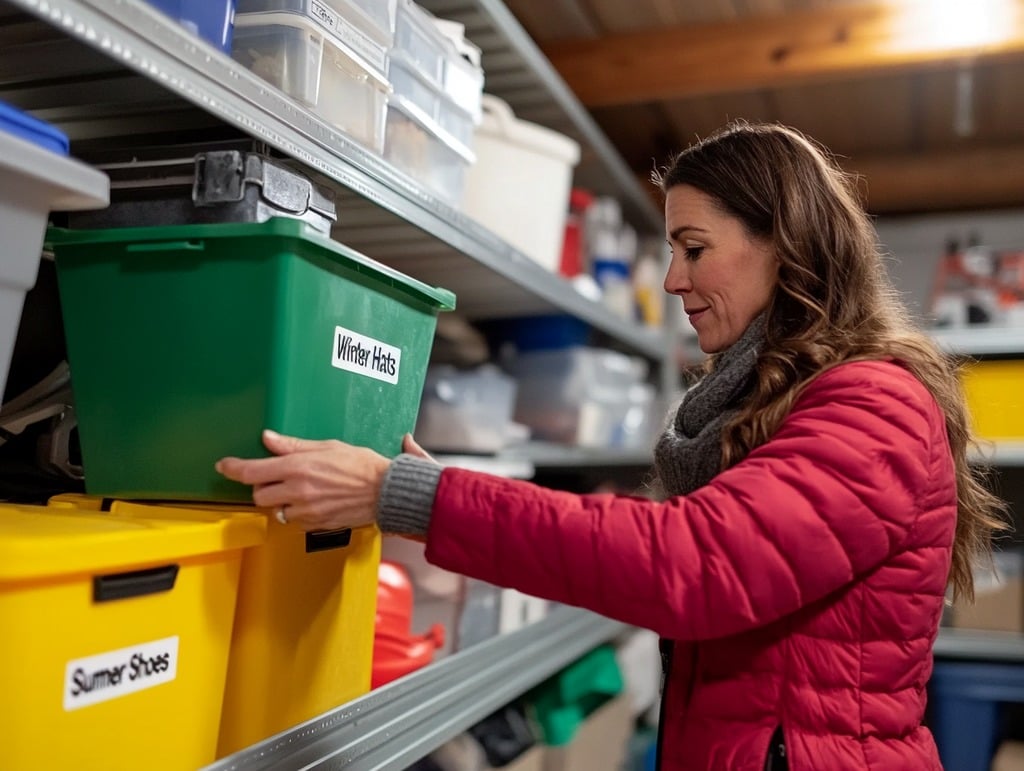As the seasons change, so do our needs for clothes, décor, and outdoor gear. Instead of letting these items pile up and create chaos, why not set up an organized system for rotating and storing seasonal items? With the right approach, you can save time, protect your belongings, and keep your home clutter-free year-round. Let’s dive into some practical, easy-to-follow tips to make seasonal storage a breeze!
1. Declutter Before Storing
Before you start packing things away, take a moment to go through everything. Ask yourself: do you still use it? Is it in good condition? Does it bring you joy? Here’s how to approach decluttering for each category of seasonal items:
- Clothes: Donate or sell items you didn’t wear last season. If you didn’t wear it in the past year, you probably won’t wear it next season either.
- Décor: Toss out or donate decorations that are damaged, outdated, or just not your style anymore.
- Outdoor Gear: Check for damage on camping or sports gear and get rid of anything that’s too worn out.
By clearing out the clutter first, you’ll save on storage space and make future rotations faster.
2. Categorize and Label Everything
Organizing items by category helps you find exactly what you need without digging through boxes. Here’s a breakdown of categories you might consider:
- Clothing (winter, summer, sports gear)
- Holiday Décor (Christmas, Halloween, Easter)
- Outdoor Gear (camping, gardening, pool supplies)
- Linens and Bedding (for warm or cold months)
Once you’ve sorted everything, use clear and consistent labels. A simple label like “Winter Clothing” or “Holiday Décor – Halloween” will make it easy to find what you need at a glance. For even more efficiency, list the contents on the label, such as “Winter Clothing: sweaters, jackets, hats.”
3. Choose the Right Storage Containers
Not all storage containers are created equal! Choosing the right type will help protect your items and maximize space.
- Plastic Bins with Lids: These are ideal for clothes, decorations, and other items that need protection from moisture and dust. Opt for clear bins so you can see what’s inside.
- Vacuum-Sealed Bags: Perfect for bulky clothing like winter coats and blankets. They save a ton of space by compressing items.
- Zippered Fabric Bags: Great for linens and items you want to keep dust-free without the risk of moisture buildup.
- Shelving Units: If you have a basement or garage, consider investing in shelving units. They make stacking bins safer and more organized.
Avoid using cardboard boxes, especially in areas like basements or attics where moisture could be an issue. Cardboard can attract pests and may not protect your items well.
4. Utilize Prime Storage Spots Wisely
Storing items seasonally requires some creativity with space. Here are a few smart spots to consider:
- Under-Bed Storage: Utilize storage bins designed to fit under the bed. This space is perfect for off-season clothes, shoes, or even extra linens.
- Closet Shelves: Use high closet shelves for seasonal items that you don’t need immediate access to.
- Basement or Attic: If you have these spaces available, they’re ideal for larger, bulkier seasonal items. Just make sure to use airtight containers to protect against humidity.
- Garage Wall Racks: For outdoor or sports gear, wall racks in the garage keep everything off the floor and accessible.
If you’re short on storage space, look for furniture with built-in storage, like ottomans with removable tops or beds with drawers.
5. Create a Seasonal Rotation Schedule
A simple seasonal rotation schedule can save you time and prevent last-minute scrambling. Here’s a suggested plan:
- Spring: Pack away winter coats, boots, heavy blankets, and holiday decorations. Bring out lighter clothing, spring décor, and gardening tools.
- Summer: Store spring jackets and replace them with summer clothes, beach gear, and camping supplies.
- Fall: Put away summer items like swimsuits and patio furniture. Bring out sweaters, rain gear, and fall decorations.
- Winter: Swap out fall clothes for winter coats and scarves, and bring out holiday decorations.
Set a reminder on your calendar to check and rotate items at the beginning of each season. This way, you’re always prepared without any last-minute stress.
6. Protect Sensitive Items
Certain seasonal items, like clothing, décor, and electronics, may need extra care during storage. Here’s how to protect them:
- Clothing: Add cedar balls or sachets to bins to keep moths away, especially for wool items.
- Electronics: Store in their original boxes if possible, and keep them in climate-controlled areas to avoid extreme temperatures.
- Fragile Décor: Wrap fragile items in bubble wrap or packing paper. Consider using dividers within bins to prevent breakage.
Taking these small steps can help your belongings stay in great shape, saving you money and hassle in the long run.
7. Label Boxes by Season for Easy Access
This might seem like a small step, but it makes a big difference. By labeling your storage boxes by season (e.g., “Fall Décor” or “Winter Clothes”), you’ll be able to grab exactly what you need each time the seasons change.
8. Maximize Space with Vertical Storage
When floor space is limited, think vertical! Use wall-mounted shelves or vertical storage solutions like hanging organizers. Here are some ideas:
- Hanging Storage Racks for closets or garage walls to store things like scarves, bags, or tools.
- Vertical Shelving in storage rooms or closets to make the most of overhead space.
- Over-the-Door Organizers for items like hats, scarves, or holiday decorations.
Vertical storage can help you make the most of limited space without cluttering the floor.
9. Invest in Clear Storage Solutions for Easy Visibility
While labeled boxes are great, clear storage bins take things a step further by letting you see exactly what’s inside without opening each container. This small investment can make seasonal rotations faster and more efficient. Plus, if you stack bins, you’ll know what’s at the bottom without having to rearrange everything.
10. Digitize Your Storage Inventory
If you have a lot of seasonal items, creating a simple digital inventory can be incredibly helpful. Here’s how:
- Use an app like Google Keep, Evernote, or even a simple spreadsheet to track what’s in each box.
- Snap a photo of each container’s contents and attach it to your inventory list.
- List the storage location (e.g., “Garage Shelf 2”) so you know exactly where each item is.
This way, if you’re ever looking for a specific item, a quick search in your inventory can tell you exactly where to find it.
FAQs on Rotating & Storing Seasonal Items
Q: How often should I rotate seasonal items?
A: Rotating at the start of each season works best. This keeps your space organized and ensures you have the right items on hand when you need them.
Q: What’s the best way to store seasonal clothes?
A: Use vacuum-sealed bags for bulky items and plastic bins with lids for regular clothes. Adding cedar balls can also help keep moths away.
Q: Should I store seasonal items in the basement or attic?
A: Both are fine as long as they’re dry and well-ventilated. Use airtight bins to protect items from moisture in these areas.
Q: How can I save space in a small home?
A: Use vertical storage, under-bed storage, and furniture with built-in storage to maximize limited space.
Wrapping Up: Keep It Simple, Keep It Organized
Rotating and storing seasonal items doesn’t have to be a hassle. By creating a straightforward system that works for you, you can make each seasonal transition a little easier and keep your home organized year-round. Remember, declutter first, categorize and label, and use the right storage solutions to protect your belongings. With these tips, you’ll be a pro at seasonal storage in no time!
Happy organizing!







